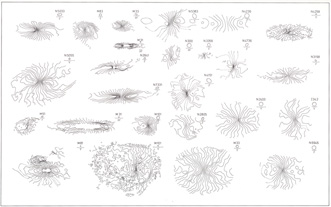


In Fig. 1 we show the velocity fields of most of the galaxies listed in table 2.1. The pictures have been oriented such that the major axes in the inner parts are (more or less) aligned with the horizontal axis. On the basis of these maps, and their relation to the optical appearance of the galaxies, we may distinguish the following types of non-circular motions:
a. Motions associated with spiral arms.
These non-circular motions are characterized by their direct association with optical and HI spiral arms. Probably the gravitational field associated with the arms leads to streaming motions which distort the axially symmetric velocity field in a regular fashion. An example of this type is the galaxy M81.
b. Large scale symmetric deviations.
In many galaxies the kinematical major axis, i.e. the line of extreme radial velocities, changes its position angle as function of radius, but the velocity field still has a central symmetry.
In cases where this major axis change is in the inner parts usually there is a misalignment with the major axis of some of the structures seen on optical photographs. We then suspect an oval (in the sense of broadly elliptical) distortion to be present in the potential field of the disk.
In cases where the major axis change is in the outer parts the major axis of the inner parts of the optically visible disk is usually well aligned. In these cases we suspect the plane of the galaxy to be warped. Since we infer the warp from the velocity field we call this warp a kinematical warp; a warp inferred from the HI distribution in edge-on galaxies we call a direct warp.
Note that there is some ambiguity in the proposed-split up a warped barred spiral will show misalignment of the kinematical major axis with the major axes of probably all the optical structures. There is, however, a marked difference between the HI column density distributions in the two cases. In the case of an oval distortion the HI distribution is confined to the optically visible arm- or ring-structures in the outer parts, in the case of a kinematical warp the HI continues outwards smoothly, usually beyond the optically visible material on sky-limited IIIaJ-plates.
c. Large scale asymmetries.
These asymmetries occur mainly in the outer parts of some galaxies and prohibit the inference of the geometry of the outer parts from symmetry arguments. Usually they can be attributed to tidal interaction with a neighbouring galaxy.
d. Small scale asymmetries.
These asymmetries are of an irregular nature; in general their amplitude does not exceed 20 km s-1. Most, if not all, galaxies show these asymmetries in addition to the others mentioned above, e.g. one half of the galaxy does not have exactly the same properties as the other half.
 |
Figure 1. Velocity field of 22 spirals taken from the sources listed in Table 2.1. All pictures have been oriented such that the major axis is roughly horizontal. The hatched areas represent the beamwidths. |
Of course this list is only meant as a guide towards identifying specific problems arising from the analysis of 21-cm line data of spiral galaxies. Most galaxies show more than one type of non-circular motions, but the relative amplitude of these motions is different. Moreover, the effect of beamsmoothing should not be overlooked. Non-circular motions of types b, c, and d will show up already at low-resolution (ratio radius / beamsize, R/B, about 5), while those of type a appear only for R/B larger than about 10 - 15. Sometimes it is difficult to distinguish solely on the basis of the velocity field which type of non-circular motions dominate: in those cases additional arguments, based on the HI column density distribution and on the optical morphology, have to be given to see which description fits best.
In the following sections we discuss each of the deviations in turn. In some cases we will present descriptive models, while in other cases we will limit ourselves to a brief discussion of relevant material available in the literature. The aim of our descriptions is to emphasize that there are unresolved riddles in the observations which are not only interesting in themselves but also have their consequences for the determination of the radial distribution of mass surface density of neutral hydrogen and of the rotation curve.